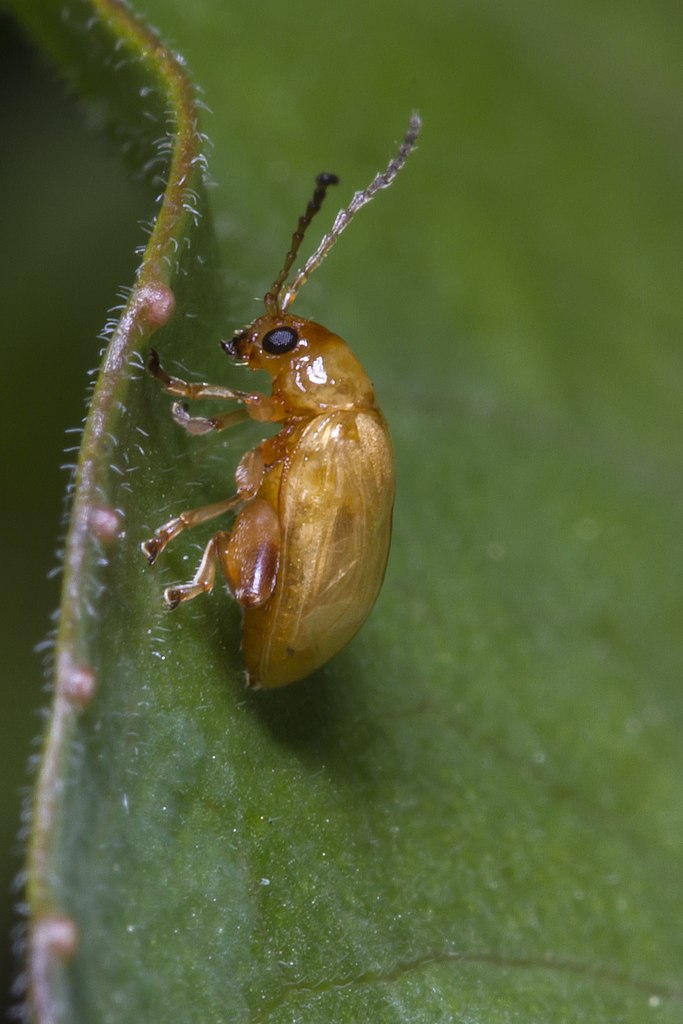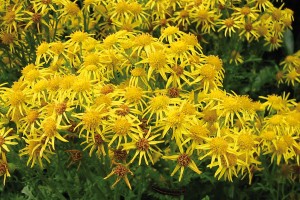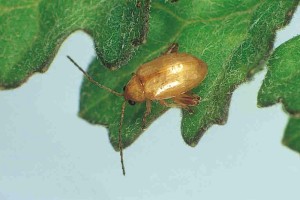Ragwort flea beetle
History in New Zealand
The ragwort flea beetle was imported from the USA by the DSIR in 1981. The beetle is native to Europe, and the American population originated from Italy. Nucleus beetle populations were mass reared and liberated widely during the late 1980s and early 1990s. As a result, the beetle is now widespread and has had a major impact on ragwort plant populations throughout New Zealand.
How would I find/recognise it and what is its lifecycle?
The best time to look for the adult beetles and their small square-shaped feeding holes is on leafy ragwort plants in autumn. You may also see adult beetles in winter and spring if they are completing two generations per year in your area. However, the beetles are not commonly found anywhere in New Zealand due to the significant reduction in ragwort plant populations. The golden-brown beetles are small (2.5-3.8 mm long) with large hind legs adapted for jumping - when disturbed they can easily leap 1 m.
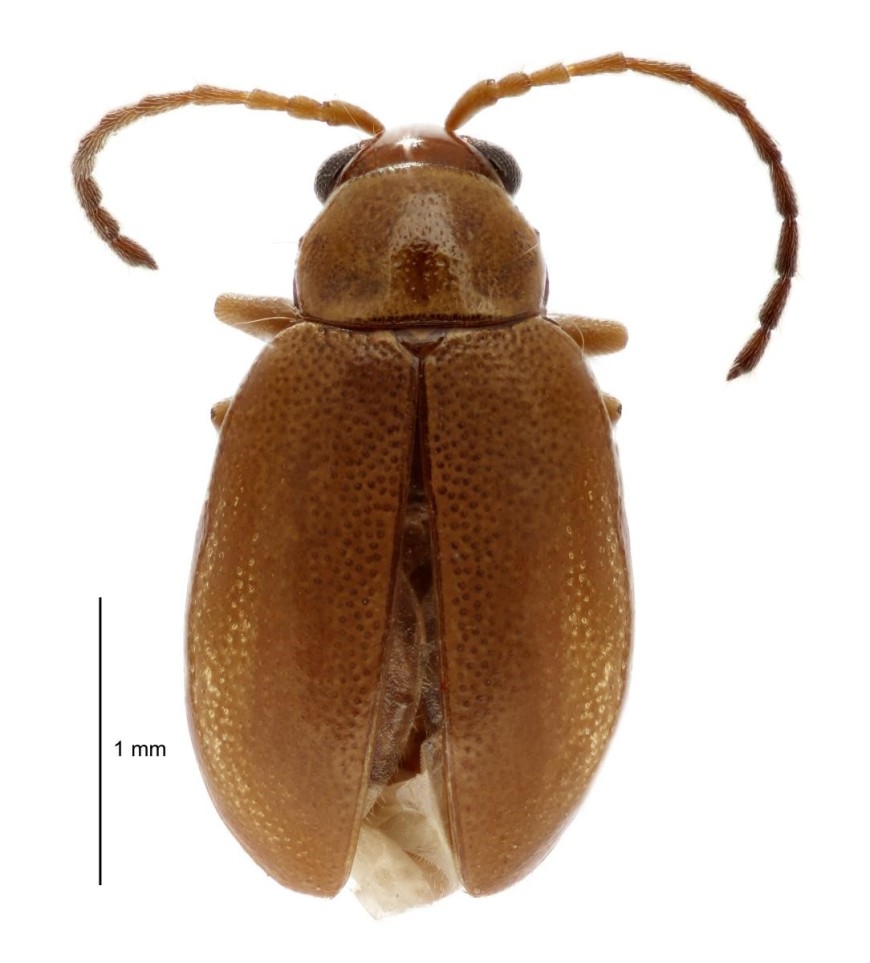
Image: ragwort flea beetle (Longitarsus jacobaeae).
You may also see new pale-coloured adults when they first appear in early summer. You are unlikely to see beetles in late summer when they undergo a resting stage (aestivation). This behaviour ensures that eggs are laid in autumn not summer, when they would desiccate. The eggs are tiny (less than 1 mm long) and are laid singly around the crown of plants or in the surrounding soil.
During the cooler months of the year you can search for the damaging larval stage. Larvae hatch after 2-3 weeks and you may see them feeding on the roots, inside the crown, and within the leaf petioles (the stem where the leaf is attached to the plant) from autumn to spring. The easiest way to find the whitish grubs is to pull a leaf off a rosette plant and examine the end of the petiole. You may need to rip the petiole in half to find the grub inside.
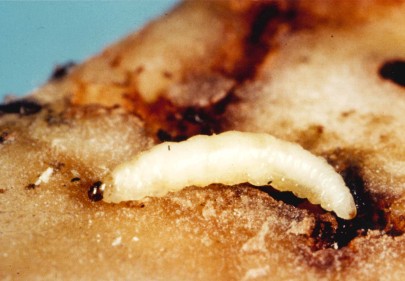
Image: ragwort flea beetle larva.
Alternatively, dig up a rosette plant and cut it open to look for the larvae inside. You will not see the pupae as mature larvae pupate in earthen cells in the soil for 2-3 weeks.
Although the flea beetle has only one generation per year in its native range, in some parts of New Zealand, it appears to be completing two.
The ragwort flea beetle is easy to differentiate from other ragwort biocontrol agents but is sometimes mistaken for a pest species: the bronze beetle. See Insects commonly mistaken for biocontrol agents, Cinnabar moth, Ragwort plume moth, Ragwort seedfly.
How does it damage ragwort?
The adult beetles feed on leaves but the damage is inconsequential. The major damage is caused by the larvae feeding on the roots and crown of the plant. Heavily infested rosette plants die. Plants that are not killed produce fewer flowering stems and therefore less seed.
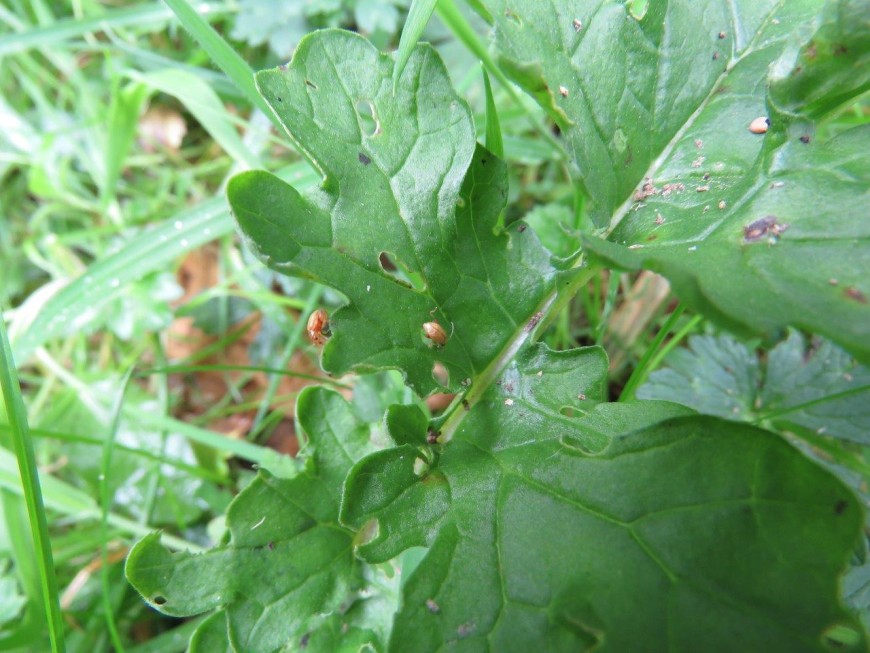
Image: ragwort flea beetle adult feeding damage.
Will it attack other plants?
No, the beetle will damage only ragwort.
How effective is it?
The ragwort flea beetle has been highly successful at controlling ragwort in New Zealand and in many countries overseas. Typically, in New Zealand, ragwort populations are substantially reduced within 2 to 10 years after the beetles have established and occasionally, it disappears altogether. However, because substantial seedbanks still exist, ragwort populations sometimes reappear in subsequent years, only to eventually be controlled by the beetle once again. Over time, the ability of ragwort to bounce back like this will be reduced as seedbanks become depleted.
The beetles have not been uniformly effective throughout New Zealand, as the wide variety of habitats and management regimes in which ragwort grows are not all ideal for the flea beetle. In particular, spraying with herbicide can prevent the beetles from building up damaging populations. High rainfall in areas, such as the West Coast of the South Island, also limits the effectiveness of the beetle. Ragwort populations do best when there is high rainfall along with ground disturbance. But high rainfall appears to have a negative effect on flea beetle populations as beetle density appears to be lower at these sites. The ragwort plume moth is better suited to high rainfall areas and has been introduced for this purpose. The plume moth is now making inroads into these remaining ragwort control strongholds.
What are the economic benefits?
A recent economic analysis has predicted that the savings in ragwort control costs on dairy farms in New Zealand as a result of biocontrol by the flea beetle to be $43 million for 2015 alone. These annual savings are ongoing and sustainable, with no further investment needed. A net present value analysis of the annual benefits and costs gave a benefit-cost ratio of 14:1, i.e. for every dollar invested in ragwort biocontrol New Zealand has gained $14 in reduced ragwort control costs. This is a conservative figure since neither the costs of lost production, stock losses due to poisoning, nor the benefits from ragwort biocontrol to other sectors of the farming community such as deer or sheep and beef farming, were included in the analysis. A decision to not proceed with the ragwort flea beetle as a biocontrol agent in the 1930s (its effectiveness was under appreciated), has proven to be very costly. Had the beetle been introduced then it has been estimated that New Zealand would have saved a staggering $7 billion in today’s terms.
How can I get the most out of it?
Although ragwort flea beetles can fly, they can take a long time to invade new areas. Studies of the beetles' dispersal patterns have shown that they may take more than 5 years to spread 1 km. If beetles are not present in your area, you can accelerate dispersal by collecting and shifting beetles from well-established sites. The best time to relocate the beetles is in the autumn. In March, the beetles' wing muscles degenerate, encouraging them to stay in one place while laying eggs. However, it may be possible to shift the beetles any time adults are present in good numbers.
How do I select a release site?
Read Guidelines for selecting release sites for biocontrol agents.
How do I collect it for release at other sites?
It is difficult to find the flea beetles due to the reduced presence of the ragwort plants caused by the impacts of the flea beetle and plume moth. If you can find them then you can collect ragwort flea beetles using a garden leaf-blower/vacuum machine.
You can purchase one of these machines from a garden equipment supplier or borrow one from an equipment hire firm. You could also use an ordinary vacuum cleaner if you have access to a portable generator. Modify the tube of the garden-leaf vacuum so that the beetles are collected and not sucked through. Take a sleeve of coarsely-woven material, with one end sewn or tied shut and the other end open (old socks or pantyhose could also be used), and fit it securely around the end so that it forms a bag in the mouth of the tube. Vacuum ragwort rosettes one at a time. For best results touch the leaves and form a seal with the ground-for large rosettes you may need to divide the plant into sections and vacuum each section for 2-3 seconds. Every 10 minutes or so, take the sleeve off the end and tip the beetles into a holding container. We recommend that you shift at least 300 beetles. Use a pooter to separate the beetles from other material collected during the vacuuming process, which many include pasture pests.
How do I manage the release sites?
Ensure that the ragwort at the release point is not heavily grazed and if possible it is best to avoid areas that will need to be sprayed with herbicide.
Key contact


